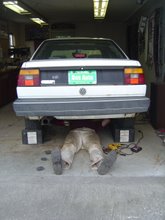First, the Saturn's polymer body panels do not rust - this an attribute that has kept mine out of the ever overloaded American waste stream. Even better, at fifteen-years-old, it still returns between 37 to 40 miles-per-gallon during highway driving. To think, this is not far behind the much touted Toyota Yaris or Honda Fit - vehicles engineered in the current century. It is true that the Saturn SL1 is - in the automotive world - an ancient design. But, it was so successful a design - ancient or otherwise - that it was produced for twelve years with little more than safety and cosmetic updates. The Green Book - which annually ranks the most environmentally friendly vehicles - listed the 2002 Saturn SL1 (this its last production year) as the twelfth greenest vehicle sold in the United States. To put this into perspective, the top ranking green cars of the same year were the Honda Insight, Honda Civic GX, Toyota RAV 4 EV and the Toyota Prius. Each of these vehicles featured emerging technologies such as continuously variable transmissions, electric and hybrid drivetrains or alternative fuels such as compressed natural gas. Meanwhile, the Saturn SL1 remained a viable green alternative while employing traditional - albeit efficiently implemented - technologies.
Older vehicles, however, are just not as safe - mainly because current models are designed to meet more stringent safety regulations - but also because older vehicles are - well - old and in need of repair. In a perfect world, I could go down to Cars-R-Us and pick up a spanking new, fuel-sipper. Unfortunately, my tax stimulus won’t cover the sticker on a Prius. Even if I could swing the payments, buying a new car - even one as fuel efficient as a Prius - doesn‘t make good economic sense. The Prius, according to the EPA, gets 45 miles-per-gallon on the highway. I think (considering that the EPA recently revised its fuel-economy ratings to reflect the more aggressive driving practices of modern, me-first Americans) that a properly driven Prius can do much better. Did you hear me Al Gore the third?
Anyway, that's about eight miles-per-gallon more than my Saturn. A new Prius lists for $23,370. Because I carpool, I only drive one week out of three. That means I drive about 17 weeks per year. My commute is 52 miles-per-day over five days for a total of 260 miles-per-week or 4,420 miles-per-year. Currently, a gallon of regular un-leaded goes for $3.25. Divide 4,420 miles by 45 and multiply this by $3.25 and the answer - $319.22 - is the yearly fuel cost of my commute in a Prius. This same sort of math will reveal the yearly fuel cost of my commute in the Saturn to be $388.24. The savings figures out to be $69.02 per year. It would take me about 338 years to recover the purchase price of the Prius in gas savings. So, by circumstance and simple arithmetic, I am committed to my current auto.
My Saturn now registers 148,830 miles on its odometer, and- if I want to keep this old warrior on the road past the 200k mark - it's going to need some work. Rust, that evil tin worm, has embedded itself within the “space frame” that lies beneath the Saturn's polymer body panels. The “space frame” is Saturn's term for the metal under structure that gives the SL1 it’s rigidity - an important safety feature for those interested in not being crushed during an accident. Winter road conditions in Vermont are notorious for inducing this sort of frame rot and its allied disorders.
For those of you unfamiliar with the harsh weather of the Northeast - well, stay south. See, when the roads get slick up here the plowmen lay down thick beds of salt to thaw the ice. Water freezes at 32 degrees Fahrenheit. Rock salt works by altering this freezing point. When the salt hits the street it couples with the available moisture to form - bet you didn't see this coming - salt water which freezes at zero degrees Fahrenheit.That's great for keeping the roads clear, however, salt has very corrosive properties, especially when its mixed with snow and ice to form a sort of rust-inducing slurry that gets slung from car tires into all the dark and hard to clean crevices of the typical automotive underbelly. Its going to get real graphic from here on, so, if you have a weak stomach you best point your browser to someplace like: http://www.iwantmymom.com/ .

Behold rust. This rocker needs to be ripped out and new metal will have to be welded in. Grizzly stuff. If left unchecked, I could lose my Saturn, like I did my ’88 Chevy Celebrity, to necrotizing metallicitis. Yes, I drove a Chevy Celebrity. It was even red - well, actually several different shades of red and a couple tints of orange. I bought it for $300 with about 301,000 miles on the clock. More than 20,000 miles later - after the strut towers had completely rusted - I sold it for $150. The only money I put into that car was for gas and oil changes. Try to get that sort of return on your bus pass.
Modern rust proofing - if you still consider the '90s modern - has come a long way. And thanks to these engineering improvements, my Saturn has a fair prognosis. Some parts of the “space frame” - like doors - can be replaced outright while others - like rocker panels - must be directly mended. During the next few weeks I will be trawling the local scrap yards for replacement parts. Now, if only I could retrofit my Saturn with the Yaris’s side airbags.

No comments:
Post a Comment